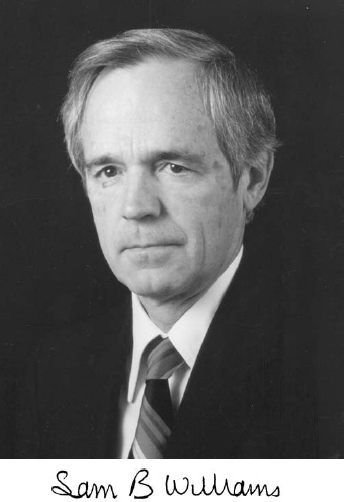1921–2009
Elected in 1986
“For outstanding engineering achievements in advancing
small gas-turbine-engine technologies, and for
major contributions to aeronautical and automotive propulsion.”
SUBMITTED BY THE NAE HOME SECRETARY
SAM B. WILLIAMS, an aerospace pioneer who left his mark on both military and civil aviation, died on June 22, 2009, at the age of 88.
Sam was born in Seattle, Washington, on May 27, 1921, and grew up in Columbus, Ohio. After earning a mechanical engineering degree from Purdue University in 1942, he worked for Chrysler, designing and developing the engine for its turbine car. When Chrysler’s enthusiasm for turbine cars began to wane, Sam left in 1955 to found Williams Research (later renamed Williams International). He was convinced that if his new company developed small, simple, affordable turbines, new markets would follow.
Turbine technology had advanced rapidly since its invention in the run-up to World War II, but most of the progress was in large, complicated engines for fighter planes, and then airliners. Sam steered turbine technology in a new direction, developing miniature turbines that were far simpler thanks to his genius for replacing many parts that each perform one function with a single part that performs many functions.
New markets did follow. Thanks to Williams, turbojets were now small enough, and affordable enough, that they powered drones the U.S. Navy used for target practice. And once Williams demonstrated a fuel-efficient twin-spool
turbofan engine small enough to be worn like a backpack, the U.S. Department of Defense was persuaded that this same technology could make long-range cruise missiles possible.
Sam pursued his lifelong dream of making jet travel safe, convenient, and affordable, and his team certified its first man-rated turbofan engine, the FJ44-1, in 1992. By 2010 more than 4,000 FJ44 engines had entered service, powering a new class of cleaner, quieter, more affordable light jets.
Sam’s role in creating new technologies earned him and his team four of the highest awards in aerospace—the Collier Trophy, the Wright Brothers Memorial Trophy, the National Medal of Technology, and the National Aviation Hall of Fame.
Sam could see things others couldn’t—simpler solutions, the flow of air, a future of small jet planes. His gift for the unseen was great. Maybe this gift was compensation for his poor eyesight or maybe it just reflected his creative mind. But whatever its source, there was no disputing his vision, because Sam had the drive to realize the things he imagined. His legacy included revolutionary products, 72 patents, and a continuous quest for the next invention.
Dr. Williams also applied his gift for innovation to the many charities he supported, especially through his promotion of inventors and inventions in medical research for cancer and degenerative eye diseases—one of the most notable being his cofounding of Second Sight Medical Products, Inc., which developed and is now producing the world’s first visual prosthetic device, or “bionic eye.”
Sam Williams is survived by his wife of 54 years, Barbara Gibson Williams, two sons and a daughter, and three grandchildren. His son Gregg, who had been president and chief executive officer of Williams International for many years, assumed the title of chairman after his father’s death.





